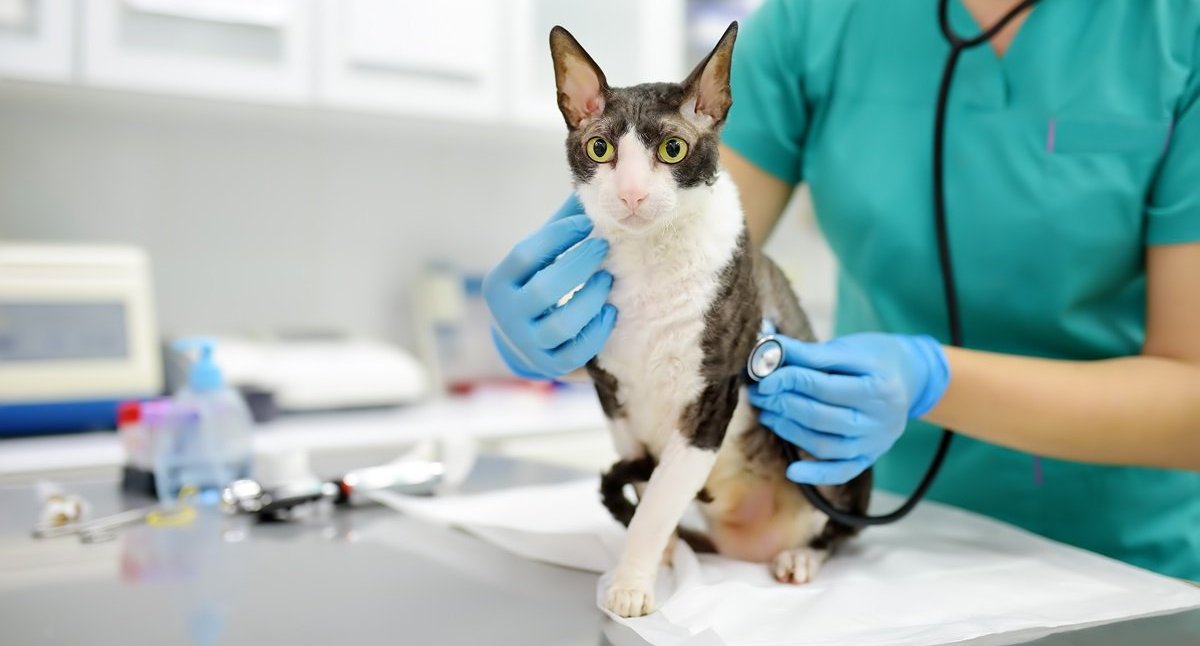
The veterinarian listens to the cat’s heart and lungs as part of a routine pet care visit. Maria Sbytova / Shutterstock.com
The importance of preventative care cannot be understated. High-quality preventive care is vital for all pets’ well-being and longevity. Pet wellness plans provide an affordable way to cover your cat’s preventive care costs throughout their life. Do your research and carefully study each plan’s details to determine which will best meet your cat’s wellness needs.
Before signing up for a wellness plan for your cat, it’s essential to understand how the plans work and what they cover. I’m here to help you learn all about pet wellness plans.
What Are Pet Wellness Plans Used For?
Before detailing what pet wellness plans are used for, let’s first discuss the meaning of wellness. In human health, wellness encompasses many aspects of a person’s health, including physical, mental, emotional, and spiritual.
In the veterinary world, wellness typically describes a pet’s overall physical health and quality of life.
Pet wellness plans cover routine preventive care services that help pets maintain good physical health and enjoy a good quality of life throughout their lifetimes.
Here is a list of preventative services that pet wellness plans cover. Keep in mind that the plans may vary in which services are included:
Wellness exams
Routine vaccines (e.g., rabies)
Fecal exams and deworming
Spays and neuters
Heartworm testing
Heartworm prevention medications
Flea and tick preventatives
Routine blood work and urinalysis
Feline leukemia virus testing
Professional teeth cleanings
Microchip implantation
Wellness plans do not cover services outside the realm of routine veterinary care. Here is a list of services not covered by wellness plans:
Emergency services (e.g., emergency surgery)
Illnesses
Accidents
Prescription medications
Supplements
Experimental treatment
Hereditary conditions
Diagnostic imaging, like ultrasounds and MRIs
Surgeries (other than spays and neuters)
Alternative therapies, like acupuncture
Pet Wellness vs. Pet Insurance for Cats
Pet wellness plans are typically sold as add-ons to pet health insurance plans. However, not all pet insurance companies sell pet wellness plans. If you already have pet insurance, check with the company to determine if they also provide wellness coverage.
Some organizations offer wellness plans on their own. Banfield Pet Hospital, a company with more than a thousand veterinary care hospitals in the US, has a wellness plan that is not associated with a pet insurance policy. “Banfield’s wellness plan covers an annual exam and annual bloodwork and may include a dental cleaning. Pet insurance covers everything you’re not expecting to happen to your cat, such as eating a foreign object and needing emergency surgery,” says Kyle Granger, DVM, an emergency and critical care resident at Colorado State University College of Veterinary Medicine.
Other private veterinary clinics may also carry pet wellness plans specific to their clinic.
Key Components of Pet Wellness Plans
Monthly premium
Covered services
Covered costs: This is the amount the wellness plan will cover for individual services. For example, a wellness plan may cover up to $80 for a wellness exam. The covered cost may or may not cover the total amount of the service.
Waiting period: This is the period before the plan goes into effect. Some plans go into effect immediately, while others may have a waiting period of a few days.
Tiered services: Some wellness plans offer tiered plans that differ in covered costs and monthly premiums. A tiered plan that pays more to cover a specific service, such as a dental cleaning, also has a higher monthly premium.
Claims process: Pet wellness plans require you to pay in full at your vet visit and then submit a claim to get reimbursed. Pet insurance companies usually try to make the claims process quick, easy, and efficient.
Unlike human health insurance, pet wellness plans typically do not have deductibles.
What Are the Benefits of Pet Wellness Plans?
Choosing a wellness plan to add to your pet insurance involves researching the cost of the wellness plans. admin_design / Shutterstock.com
One of the biggest benefits of pet wellness plans is cost savings. Since cats live an average of 10 to 15 years, you could spend a lot of money on your cat’s wellness care throughout their lifetime. Wellness plans offer an easy way to save money each year on routine veterinary care.
Pet wellness plans also make budgeting for your cat’s care easy. Monthly premiums allow you to spread out the total cost of routine veterinary care evenly over 12 months, avoiding the sticker shock of the cost of individual wellness visits.
Early illness detection is another significant benefit of pet wellness plans. Regular wellness visits allow your vet to evaluate all aspects of your cat’s health and detect illness early before it becomes advanced and more challenging (and expensive) to treat. For example, a fecal exam can help your vet identify internal parasites and prescribe treatment to kill them before they cause serious illness in your cat.
How To Choose a Pet Wellness Plan for Your Cat
Approximately a dozen major pet wellness plans are available, one of which is through Banfield. Other wellness plans are available through pet insurance companies such as Embrace and Pets Best. As mentioned earlier, individual veterinary clinics may offer wellness plans.
Deciding which plans would be best for your cat will require doing some research and a bit of number crunching.
First, estimate your cat’s wellness expenses over the course of a year. If you have an adult cat, review what you spent on wellness care the previous year to estimate how much you’ll spend this year. If you have a kitten and are about to begin their wellness care, ask your vet about the costs of kitten wellness services (e.g., deworming, spaying/neutering, core vaccinations, etc.).
Next, evaluate the annual costs of the pet wellness plans. Purchasing a wellness plan makes sense only if the annual cost is significantly less than what you’d pay out of pocket for your cat’s annual wellness care. If you plan to spend less than a plan’s annual cost, you may want to pass on purchasing a wellness plan. If you think you’ll have more expenses, consider weighing the coverage details and cost of pet insurance plans, as well.
If purchasing a wellness plan makes good financial sense, evaluate what each one covers and if tiered plans are offered. Tiered wellness plans can make it easier to select the plan that’s best suited for your cat. For example, if you have an adult cat, a higher-tiered wellness plan that covers dental cleanings (basic plans may not cover dental cleanings) could be a good option to slow the onset of dental disease.
Ideally, you could select a plan that covers all the wellness care services your cat needs and none that they don’t. However, that might not be possible. Talk with your vet if you’re having trouble deciding which wellness plan would be best for your cat.
Frequently Asked Questions
What is the difference between a pet wellness plan and pet insurance?
A pet wellness plan covers preventative care services, such as dental cleanings, vaccinations, and fecal exams. Pet insurance covers non-preventative care services, including emergencies, chronic illnesses, and accidents.
Should I add preventative care to my pet insurance?
The costs of preventative care can add up quickly, especially if you’re thinking about the cost of this care over your cat’s lifetime. Adding a wellness plan to your pet insurance could help you save a significant amount of money and give you peace of mind that your cat is receiving regular preventative care at an affordable price.
Does it cost more to add a pet wellness plan?
Yes, adding a pet wellness plan will cost more than having only a pet insurance plan. However, the cost of welless plans varies between pet insurance companies that offer these plans. Also, if the cost of the wellness plan is less than what you would normally pay for your cat’s preventative care, then the additional cost would likely be worth it.






